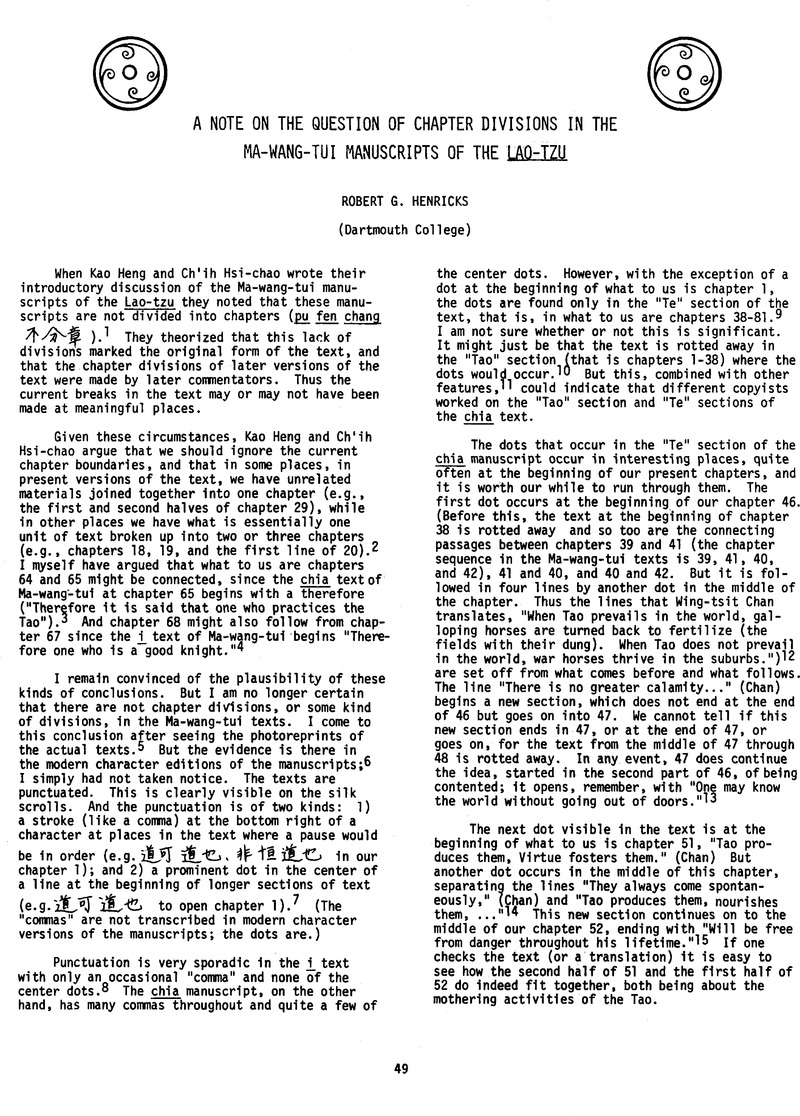Article contents
A Note on the Question of Chapter Divisions in the Ma-wang-tui Manuscripts of the Lao-tzu
Published online by Cambridge University Press: 26 March 2015
Abstract

- Type
- Research Notes
- Information
- Copyright
- Copyright © Society for the Study of Early China 1978
References
FOOTNOTES
1. See their “Shih t'an Ma-wang-tui Han mu chung ti po-shu Lao-tzu” ![]()
![]() , Wen wu, 1974:11, pp. 1–7Google Scholar. They discuss the absence of chapter divisions on pp. 3-4.
, Wen wu, 1974:11, pp. 1–7Google Scholar. They discuss the absence of chapter divisions on pp. 3-4.
2. Ibid., p. 4.
3. I present these ideas in an article entitled “Examining the Ma-wang-tui Silk Texts of the Lao-tzu: With Special Note of Their Differences from the Wang Pi Text.” This will be published in 1979 in T'oung Pao.
4. Ibid. For the text references in the Ma-wang-tui manuscripts see Lao-tzu: Ma-wang-tui Han mu Po-shu (Peking: Wen wu, 1976)Google Scholar. Chapters 64 and 65 are on p. 75; 67 and 68 are on p. 77.
5. The photoreprints are in ts'e 1 of the 8 ts'e Ma-wang-tui Han mu po-shu:1 (Peking: Wen wu, 1974).
6. In addition to the text cited in note 4 see 1) Wen wu, 1974:11 (chia text, pp. 8–14; i. pp. 15-20)Google Scholar; and 2) I-p'ing, Yen![]() Po-shu chu-chien
Po-shu chu-chien ![]()
![]() (Taipei: I-wen, 1976) (chia - pp. 51–67; i. pp. 71-87)Google Scholar.
(Taipei: I-wen, 1976) (chia - pp. 51–67; i. pp. 71-87)Google Scholar.
7. That these dots appear at the head of certain sections and not at the end of the preceding seems to follow from the fact that there 1s a long space in the chia text after chapter 79 (the last chapter in the Ma-wang-tui version of Part II. of the Lao-tzu), and the text of chapter 1 (parts I. and II. of the Lao-tzu are reversed in the Ma-wang-tui texts) begins at the top of the next line with a dot followed by tao, i.e. ![]() . See Ma-wanq-tui Han mu po-shu: 1, ts'e 1, chia photorepnnt, lines 92 and 93.
. See Ma-wanq-tui Han mu po-shu: 1, ts'e 1, chia photorepnnt, lines 92 and 93.
8. Apparently. But I do note some such marks between chapters 30 and 31, and 11 and 12.
9. There is another possible exception. There appears to be a small dot between chapters 12 and 13 although this may be an ink spot. See Ma-wang-tui Han mu po-shu:1, chia photorepnnt, line 113.
10. The text is in disrepair at many places where such dots might be found, e.g. between chapters 1 and 2, 3 and 4, 7 and 8, 9 and 10, 10 and 11, 14 and 15, 19 and 20, and 25 and 26.
11. For example shena![]() is written with the homophone
is written with the homophone ![]() throughout the “Tao” section but always with
throughout the “Tao” section but always with ![]() in “Te”. And ch'i
in “Te”. And ch'i![]() is written
is written ![]() throughout the “Tao” section but always as
throughout the “Tao” section but always as ![]() in “Te”.
in “Te”.
12. See Chan, Wing-tsit, The Way of Lao Tzu (Indianapolis: Bobbs-Merrill, 1963), p. 181Google Scholar.
13. Tr. by Chan, The Way, p. 183.
14. Note that the “therefore” (![]() ) at the start of this line in the Wang Pi text is missing in the Ma-wang-tui manuscripts. One might conclude that a later commentator added it to better tie together these two sections of chapter 51.
) at the start of this line in the Wang Pi text is missing in the Ma-wang-tui manuscripts. One might conclude that a later commentator added it to better tie together these two sections of chapter 51.
15. Chan, , The Way, p. 192Google Scholar. It is interesting to see how Chan has al ready separated the text at the right places.
16. This is reconstructed from the i text. See Lao-tzu: Ma-wanq-tui Han mu po-shu, p. 77.
17. Note the parallelism: the sage recognizes disease as disease (![]() ): the people do not fear what is dreadful (
): the people do not fear what is dreadful (![]() ), and therefore …
), and therefore …
- 2
- Cited by




